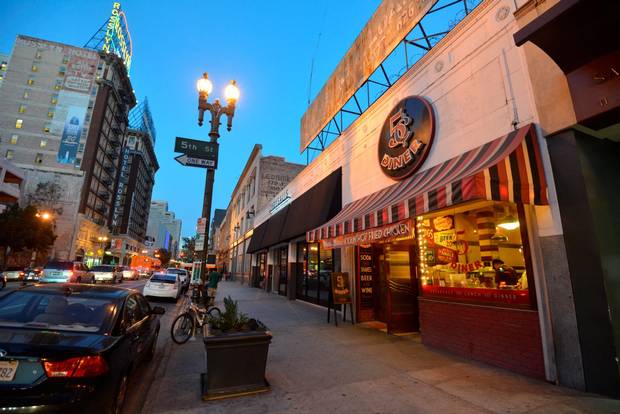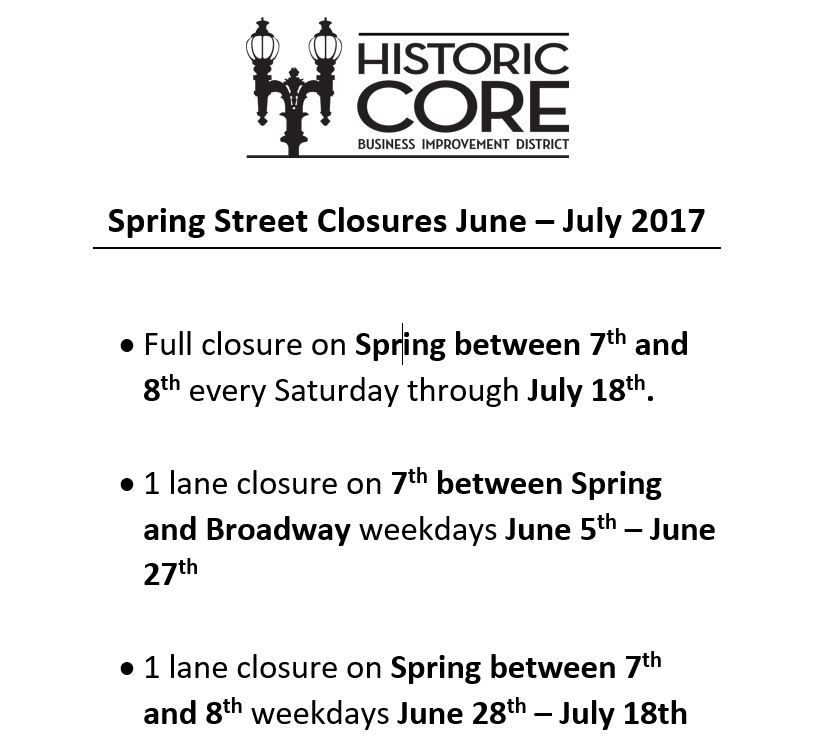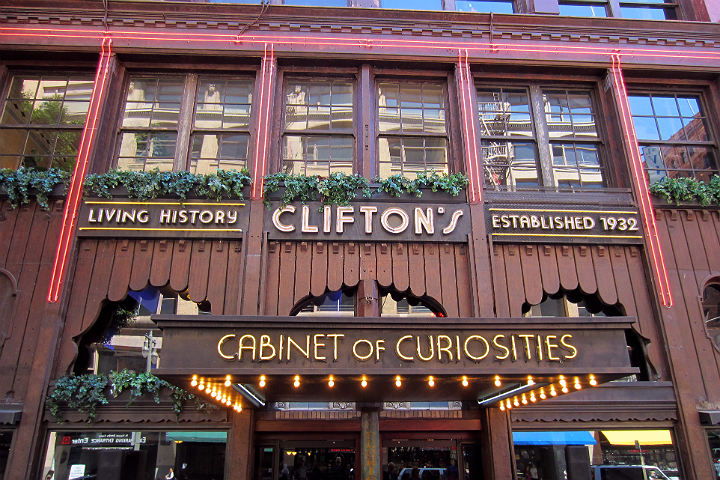By Pól Ó Conghaile, independent.ie/life/travel/world
The Nickel Diner’s grill is sizzling.
Around it, sitting in burgundy leather banquettes by wooden tables, customers are tucking into a mix of pancakes, egg scrambles and Flat Iron steaks. Ceiling fans whir lazily. A Virgin Mary statuette is embossed in velvet.
I wasn’t sure this was the place, until I stepped inside and saw a sign.
It said: ‘This is the place. There is no place quite like this place anywhere near this place, so this must be the place.’
Boxed into a block near the corner of 5th and South Main, the Nickel Diner (nickeldiner.com) is a space where the ghosts of Downtown LA past, present and future seem to meet. Desserts are chosen from a display stand of shellacked cakes, and the brunchtime crowd veers from a hipster in a ‘Free Winona’ T-shirt to older folk who wouldn’t look out of place in Making a Murderer.
I order Gio’s chilaquiles, a steaming heap of fried tortillas, poached eggs, black beans, avocado and pickled onions.
“It’s a Mexican dish,” says the waiter. “You’ll love it.”
I tuck in, and I do.
Outside, a short walk could take me to some of the most recognisable skyscrapers in the States. Or it could take me to Skid Row.
The next shop window could hold a pawnbroker or a poodle in mid-pamper session; the next block a splash of street art or a wedding chapel.
My next meal could be a hangover-slaying taco from a food truck, or ‘day boat scallops’ served with morels, nettles, spring garlic and lemon in the spanking new Redbird (redbird.la), housed in the former rectory of St Vibiana’s Cathedral.
It’s a thrilling, visceral, in-the-moment mix.
Some strips, like Restaurant Row on 7th Street, could be in any big American city. Others, such as the bazaar-like Santee Alley (three-piece suit with a free shirt and tie for $99, anyone?) or Bunker Hill, with buildings ranging from the Art Deco Edison Building to Frank Gehry’s Walt Disney Concert Hall, couldn’t be anywhere else.
Once upon a time, Downtown was the heart of Los Angeles, home to its old movie palaces, grand department stores, fashion district and later its commercial towers. As the city sprawled, however, the historic centre deteriorated into a giant parking lot by day, a no-go area by night.
Now, things are changing once again.
DTLA’s revitalisation is not a new story; lofts, galleries and restaurants have been gaining ground for years. But the sense of a neighbourhood in mid-flip – neither one thing nor the other, but a thrilling cocktail of both that nobody seems quite able to predict or control – is tantalising.
There are pricey penthouses and gritty thrift shops. The Ace Hotel has rebooted the old United Artists Building; Urban Outfitters the Rialto Theatre.
The Last Bookstore (lastbookstorela.com, see video), with its labyrinth and tunnels made of books, is both nostalgic and forward-thinking, the perfect spot to pick up your souvenir copy of The Big Sleep or Less than Zero.
As I shoot a photo outside, yet another homeless person pushes his possessions past in a trolley. Everything feels like it’s in flux. I’m excited, conflicted, pumped with adrenaline.
LA is back on the Irish radar of late – Ethiopian Airlines is flying direct from Dublin, Aer Lingus resumes its direct service in May, and WOW Air is offering one-stop fares via Iceland. There are lots of reasons to visit – from iconic draws like Venice Beach and the Walk of Fame to Universal Hollywood’s new Wizarding World of Harry Potter.
The city is sunny and diverse (people from over 180 countries call it home), but it’s also enormous and the traffic is a snarling mess.
To get under its skin, you need a neighbourhood focus.
And that neighbourhood should be Downtown.
You want movie magic? Forget Hollywood. A movie reccie here takes me to locations from Dark Knight Rises, Heat (the Citigroup Center was the scene of De Niro’s fateful final robbery) and most memorably, Bladerunner.
The iron-laced stairways and birdcage elevators of the 19th-century Bradley Building – a “fairytale of mathematics”, as one critic called it – was the set for J.F Sebastian’s apartment complex, and it’s free to enter.
I discover that you can actually walk through the stainless-steel folds of the Walt Disney Concert Hall. I step into the lobby of the LA Times building, photographing its famous globe. The Broad (thebroad.org), LA’s new contemporary art museum, marries a fish-scale-like exterior with a breathless collection of instantly-recognisable pieces.
Imagine standing in front of Andy Warhol’s Elvis, Jasper Johns’ American flag, or Jeff Koons’ Balloon Dog. Well, here you can – and it’s free too.
Finally, to the food. By now, Downtown’s random scattering of restaurants has blossomed into a full-on dining scene. Within a few blocks, you can eat yolk-spurting egg sandwiches at Eggslut (eggslut.com) in the Grand Central Market, or rustic, new American cuisine by Timothy Hollingsworth at Otium (otiumla.com).
There, a svelte and sweetly-presented glass bowl of amberjack with yuzu and smoked tangerine, dished up in Osvaldo Maiozzi’s boxy, beautiful, mezzanine-layered space, feels like the polar opposite of my Nickel Diner experience.
In fact, there’s just a five-minute cab ride between the two.
Downtown measures around five square miles, but surrounded by freeways, it feels like a city – even a timezone – in itself. Go see, before it closes this intriguing chapter.
This is the place, all right.
I stayed as a guest of the Ace Hotel (acehotel.com; from $279 plus tax). A reboot of the historic United Artists Theatre, it epitomises the second (or should that be third?) coming of DTLA, with stripped-back rooms, a photo-booth and vintage guitars in reception, hip staff and an uber-cool rooftop bar.
If you don’t stay, make a point of stopping by for a cocktail.
For more, see discoverlosangeles.com and @discoverla.




